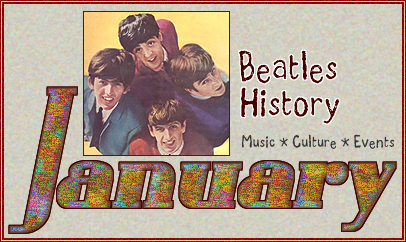 History offers History offers
a chance
to truly
understand
how the past
impacts the now.
Follow our
daily timelime
of historical
events to
discover the
role The Beatles
played in changing
the modern world.
THE FOLLOWING EVENTS TOOK PLACE ON JANUARY 5
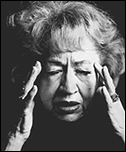 1918--Psychic Jeanne Dixon is born in Medford, Wisconsin. 1918--Psychic Jeanne Dixon is born in Medford, Wisconsin.
 1923--Sam Phillips, founder of Sun Records, is born. 1923--Sam Phillips, founder of Sun Records, is born.
1940--The Federal Communications Commission (FCC) gets its very first demonstration of FM radio. The new medium, free of interference, static, and noise in thunderstorms, was developed by Major E.H. Armstrong. The first FM transmitter would be put into operation in 1941.
1959--Buddy Holly releases his last record, It Doesn't Matter Anymore.
1961--The Beatles perform at Litherland Town Hall, Liverpool. They receive a fee of £7.5. In the audience this night are two members of the group Rory Storm and the Hurricanes: Johnny Guitar and Ringo Starr, just returned from Hamburg. This is the first of 36 bookings for promoter Brian Kelly, who had rushed to sign up The Beatles after their hugely successful performance of December 27, 1960. These appearances will help establish The Beatles as the top band in Merseyside. The demand for The Beatles becomes so great that they begin booking two and even three stage appearances in a single day, sometimes performing for more than seven hours a day. The hectic schedule and rushing from one venue to another make it essential that The Beatles find a road manager, and Pete Best's friend Neil Aspinall accepts the position. Aspinall will go on to become The Beatles' permanent assistant and close companion.
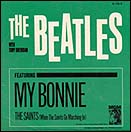
1962--UK release of Tony Sheridan and The Beatles single My Bonnie / The Saints (Polydor). This is the first time The Beatles are credited on a recording.
1962--The Beatles perform at the Cavern Club -- a lunchtime show.
1963--On a short tour of Scotland, The Beatles perform at Museum Hall, Bridge of Allan, Stirlingshire. They are billed as "The Love Me Do Boys.”
 1964--George Harrison and Ringo Starr tape an interview for the BBC radio program "The Public Ear." George and Ringo both encouraged the radio audience to listen to the music that The Beatles themselves liked, American R&B. When asked to mention some of the artists that he liked, George said "...Mary Wells, Miracles, not to mention Marvin Gaye." When Ringo responded, "Marvin Gaye!" George quipped back "I told you not to mention Marvin Gaye!" Recorded in London, exact location unknown. Broadcast on January 12. Re-broadcast in 1972 on the BBC radio documentary "The Beatles Story." [Barry Miles reports that the interview was recorded in George and Ringo's Green Street apartment in central London; Mark Lewisohn reports that it was either that apartment or Tony Hall's, which was located on the opposite side of Green Street.] 1964--George Harrison and Ringo Starr tape an interview for the BBC radio program "The Public Ear." George and Ringo both encouraged the radio audience to listen to the music that The Beatles themselves liked, American R&B. When asked to mention some of the artists that he liked, George said "...Mary Wells, Miracles, not to mention Marvin Gaye." When Ringo responded, "Marvin Gaye!" George quipped back "I told you not to mention Marvin Gaye!" Recorded in London, exact location unknown. Broadcast on January 12. Re-broadcast in 1972 on the BBC radio documentary "The Beatles Story." [Barry Miles reports that the interview was recorded in George and Ringo's Green Street apartment in central London; Mark Lewisohn reports that it was either that apartment or Tony Hall's, which was located on the opposite side of Green Street.]
1964--According to Barry Miles (in "The Beatles: a Diary"), The Beatles perform at the Astoria Cinema, Finsbury Park, London, in "The Beatles' Christmas Show." However, Mark Lewisohn (in "The Complete Beatles Chronicle") reports that no performances take place this night.
1965--The Beatles put on two performances of "Another Beatles Christmas Show" at the Hammersmith Odeon in London.
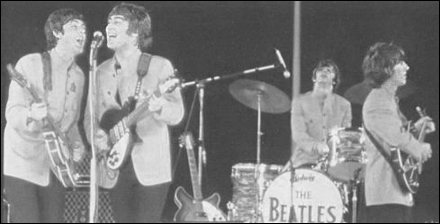
1966--At CTS Studios in London, The Beatles "doctor" the soundtrack to the film of their August 15, 1965, concert at Shea Stadium, in preparation for the film's broadcast. They re-record instrumental parts on some tracks, and on some songs they re-record the entire song, doing their best to synchronize their playing with the film. For Act Naturally, the disc version is substituted unchanged. On Twist and Shout, the Shea Stadium version is combined with the 1965 Hollywood Bowl recording of that song. The fixes are done more to correct technical problems with the soundtrack than to correct performance weaknesses. Two songs, She's a Woman and Everybody's Trying to Be My Baby, are cut from the final film due to broadcast time limitations.
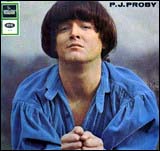 1966--Later that night, after working on tbe Shea Stadium soundtrack, John goes nightclubbing with P.J. Proby. 1966--Later that night, after working on tbe Shea Stadium soundtrack, John goes nightclubbing with P.J. Proby.
1967--The Beatles in the recording studio (Studio Two, EMI Studios, London). Paul adds another vocal overdub to Penny Lane, then The Beatles record a 13 min, 48 sec experimental sound effects track for the 'underground' theatrical production "Carnival of Lights Rave." The track includes "...distorted, hypnotic drum and organ sounds, a distorted lead guitar, the sound of a church organ, various effects (water-gargling was one) and...John and Paul screaming dementedly and bawling aloud random phrases like 'Are you alright?' and 'Barcelona!' " John would later use some of the same techniques in creating his Revolution 9.
 1968--The Beatles' movie "Magical Mystery Tour" is broadcast by BBC2 in the UK, in color (it had been broadcast in black and white on December 26, 1967, by BBC1). The critical response remains almost wholly negative. 1968--The Beatles' movie "Magical Mystery Tour" is broadcast by BBC2 in the UK, in color (it had been broadcast in black and white on December 26, 1967, by BBC1). The critical response remains almost wholly negative.
1968--George Harrison in the recording studio (Studio Two, EMI Studios, London). Producing another Wonderwall recording session. George does not play any instrument on the soundtrack.
1970--Working at Olympic Sound Studios, London, Glyn Johns completes the re-production and compilation of a new Get Back master tape. The song Teddy Boy, which will not be included in the movie, has been dropped from the album. I Me Mine and Across the Universe have been added. The master tape concludes with a reprise version of the song Get Back.
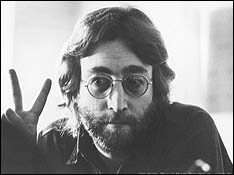 1970--Vacationing in Denmark, John Lennon announces that, henceforth, all future proceeds from his songs and records will go towards promoting peace on earth. 1970--Vacationing in Denmark, John Lennon announces that, henceforth, all future proceeds from his songs and records will go towards promoting peace on earth.
1974--Brit music paper, Melody Maker, publishes the results of its “Top Albums of ‘73” poll. The Beatles 1967-1970 is placed at number six, The Beatles 1962-1966 is number eight, and Wings’ Red Rose Speedway is number 36. (Number one was Pink Floyd’s Dark Side of the Moon.)
 1981--Woman is selected (on schedule) as the second US Double Fantasy single. There are few accusations of cashing in, as John Lennon had already been filmed for a promo clip for the single before his death. 1981--Woman is selected (on schedule) as the second US Double Fantasy single. There are few accusations of cashing in, as John Lennon had already been filmed for a promo clip for the single before his death.
1984--US release of John Lennon / Yoko Ono single Nobody Told Me / O'Sanity (Polydor / PolyGram).
1987--At his Friar Park recording studio in Henley-on-Thames, George Harrison begins recording his album Cloud Nine.
1996--Klaus Voorman travels to London and hands over to Apple his completed design for The Beatles Anthology 3.
1998--Sonny Bono dies in a skiing accident at Heavenly Ski Resort on the Nevada-California line, 55 miles southwest of Reno, Nevada. He was 62.
For more day-by-day history go to HistoryUnlimited.net
|
 History offers
History offers


